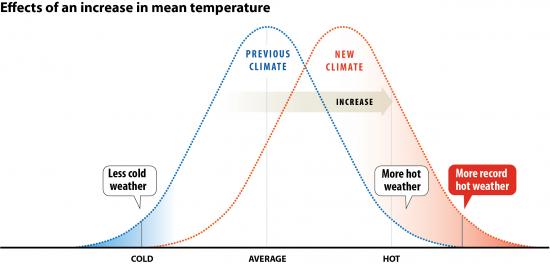A tail of record heat
Jun 2, 2011 - by Staff
Jun 2, 2011 - by Staff
David Hosansky | 2 June 2011 • How can a relatively small increase in the average temperature of the planet lead to numerous record-breaking heat waves?
The increase in average global temperatures—about 1.3º Fahrenheit since the mid-19th century—certainly doesn’t sound dramatic. Yet, the impact on extreme temperatures is clear: record high daily temperatures in the United States are outpacing record low daily temperatures by a ratio of 2 to 1.
And the situation overseas is even more telling, with unprecedented heat waves and widespread wildfires last summer across much of Asia (temperatures reached 128ºF in Pakistan) and Australia (Perth endured a record number of days in the mid-80s or above). The anomalously high temperatures aren’t just a summertime phenomenon. Canada experienced its warmest winter on record in 2009–10.
Part of the reason for the extreme warmth, at least from a statistical viewpoint, can be gleaned from this graph. The two curves illustrate how a minor increase in average temperatures can have a much greater impact at the edges, or “tails,” of the curve.

As this graphic indicates, a small shift in average temperatures can result in a significant number of record heat events. (©UCAR. This image is freely available for media use. For more information, see News media terms of use*)
“A relatively small shift in the average produces a large change in extremes,” explains NCAR scientist Jerry Meehl, who created an earlier version of the graphic. “If you shift the whole distribution a little to the right you have more extreme heat. The tail on the far right moves into uncharted territory, breaking new heat records.”
The situation is somewhat analogous to the increasing number of elderly people in the United States. There, too, a small change in the average has created a larger impact on the extremes. While average U.S. life expectancy has increased by a moderate amount over the last 50 years—from almost 70 to almost 78—the number of people living to 85 or older has increased more than fivefold.
Although an increase in life expectancy is generally regarded as positive, the impacts of a warming climate are more worrisome. Climate models have indicated that global mean temperatures will rise significantly this century unless emissions of greenhouse gases are greatly curbed. The impact on heat waves will also be magnified.
If our use of fossil fuels continues, for example, research by Meehl and his colleagues indicates that record daily high temperatures in the United States may outpace record daily lows by a ratio of 20-to-1 by midcentury. Societies will face more potentially deadly hot weather events on the scale of the 2003 heat wave in Europe that claimed an estimated 35,000 lives or more.
It’s worth noting that, as the left side of the graphic indicates, there will still be the occasional cold snap—although they will happen less frequently.
“Even in 2100, when there may be a lot more record highs,” Meehl says, “there will probably be a day when someone will call NCAR and say, ‘Hey, it’s really cold outside. What happened to global warming?’”